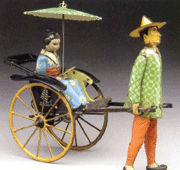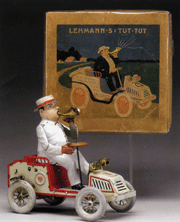|
Old Tin Toys Did Amazing Things
By Anne Gilbert
Whenever an auction catalog containing old tin toys comes
to my mailbox, I can hardly wait to check out what tricks
they could perform. The James Julia November 20 catalog
didn’t disappoint me. Those offered were late 19th to early 20th
century. Among them was a Lehman Masuyama wind-up with
a coolie pushing a rickshaw with an Oriental woman. When
wound, the coolie’s feet shuffle, the umbrella twirls and the
woman fans herself. Another has a warrior holding a club in
each hand. When wound, he does summersaults.
These days with prices
of sometimes $6,000,
these are toys for adults.
Tin toys are made from sheet iron plated with a protective
later of tin to keep them from rusting. In the 19th century with
the development of powered machinery and the invention of
chromolithography, it was possible to turn out thousands of
toys inexpensively. Nuremberg Germany became the chief
maker and exporter. However, that changed after World War I.
By the 1920s and 30s, with Germany recovering from defeat, the tin-plated toy market
had shifted to other countries, as
well as Japan and the United States.
However, their products weren’t
as well made as Germanys’ earlier toys.
Just before World War II, Germany was once again
making quality toys. After World War II, once again Germany
began producing tin-plated toys. Up to the 1950s they were
marked “Made in the US Zone.” Those made in post-war Japan were marked “Occupied
Japan.” These toys are considered
serious collectibles since they were
made with those marks for such a
brief time.
CLUES: Japanese toys made in
the post-war 1950s, marked “Made
in Japan” keep going up in price.
What makes them so special are the
innovations that included robot toys
with flashing lights, loud noises
and battery-operated or clock-work
cartoon characters.
There are several categories
that are collected, including
transportation, which would
include horse and carriage, buses,
locomotives, cabs and early
airplanes. There are also hot air
balloons and nautical toys. Other
categories are jack-in-the-box, farm
animals, circus clowns, dolls and
robots.
Reproductions can be a
problem with the early German
toys. If the paint is too bright, the
piece is either a repro or has been touched
up. Moveable toys should move, and if key
wind, have the key. Some ‘50s toys have
been re-issued. Among the makers are Paya
of Spain, and Schuco toys made under the
German firm trademarked GAMA.
Beware of “married” toys. This means
new parts have been added that didn’t
originally belong. Original boxes with toys
usually double their value.
|

Lehmann
Masuyama wind-up tin
toy. (Photos, James
Julia Auctions, Fairfield,
Me.)

Lehmann Tut-Tut wind-up
tin toy with original
box. |